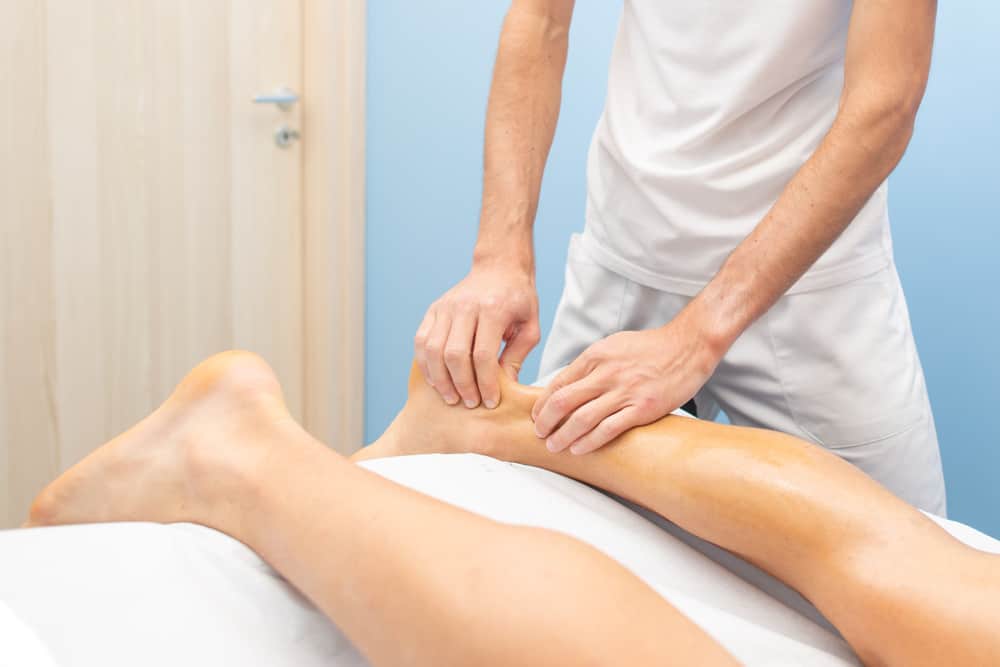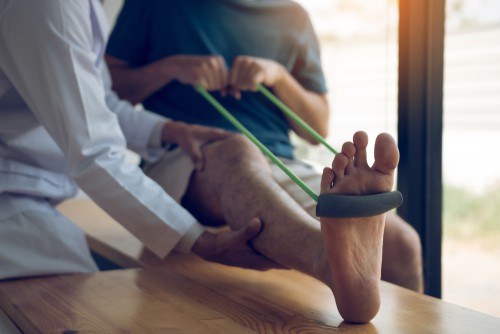
The Achilles tendon is the largest tendon in our body and can be prone to injury. A lot of stress is placed on the tendon as it is responsible to lift your heel off the ground and propel our body forward when we walk or run. It also plays a function in helping us to balance and jump which is why we should all stretch our Achilles tendon regularly.
The basics – There are two muscles that attach to the Achilles tendon.1 One is the gastrocnemius muscle. This is the large muscle that forms the muscle bulk you see in your leg. The other muscle is the soleus muscle which lies deep beneath the gastrocnemius muscle. It’s a flat but very powerful muscle. There are some anatomical differences between the two muscles.
Anatomy -The gastrocnemius muscle attaches to the Achilles and its origin is above the knee. It attaches to the femur bone above the knee joint. The soleus muscle originates from an area called the soleal sling which is a fibrous band of tissue below the knee joint. These differences are important because when the knee is straight your notice that you’ll feel more pull than when your knee is flexed. This is because the large gastrocnemius muscle originates above the knee flexion of the knee, it will reduce the pull while the extension of the knee will cause more pull (tension) on the muscle. This is important to know because when you pull your foot up towards you when you stretch you won’t be effectively stretching the gastrocnemius muscle as much when your knee is bent as when it is extended. So it is preferred that the majority of stretching of the Achilles should be done with the knee straight.
Options for stretching to reduce stress on the Achilles tendon.
How to stretch while sitting?
While sitting on the floor you can use a towel or a stretching band. This is referred to as resistance band calf stretch. Place it against the ball of your foot. Then with your leg extended holding the towel or stretching band pull the foot up towards you. Do it slowly and make sure to hold the stretch for 30 seconds. Then switch to the other foot and repeat one to four times.

How to stretch while standing?
- Standing wall stretch
While facing a wall place one foot behind you and one foot closer to the wall. The foot furthest from the wall will be stretched. Think about moving your hips forward towards the wall to stretch the Achilles tendon. It’s also important to point your foot forward toward the wall. If your foot is facing out it’s likely to be in a pronated (flattened Position) and this will cause your foot to flex, and you’ll have less flexion at the ankle joint where it is needed. Lean forward keeping your knee straighten to get a maximum stretch. Do it slowly and hold for 30 seconds. Repeat 1-4 times and then switch legs.
- Standing toe raises
The exercise helps to stretch the Achilles but also has the advantage of strengthening your gastrocnemius and soleus muscles. To do this exercise make sure that you can hold onto something stable to help you balance. This could be a table, counter, or handrail on the stairs. You can stand on some steps with the ball of your foot supported on the steps and your heel off the steps so it is hovering. You should not be bearing weight on the opposite foot. Then allow the heel of the foot to drop down The same process can be accomplished standing on a board, curb, or large book. Now simply relax your calf muscles and allow your heel to drop below the surface you’re standing on to create stretches on the muscles and Achilles. Hold for 5 seconds. Then lift the heel so you rise onto the ball of the foot. Repeat this 8–10-time times. Then switch sides.
How to stretch the Achilles tendon properly?
Make sure you do your stretching slowly, no need to bounce. The muscles are more likely to relax using this technique.
Hold for 30 seconds. When you feel the stretch of your achilles tendon, it’s important to hold for the pose for 30 seconds. The muscles will be more likely to relax and stretch. Remember the natural response the muscle will have immediately when stretched is to contract so a longer time is better.
If you’re feeling any pain while you’re doing your stretch stop.
Important word of CAUTION!
Finally. Use caution if you have significant Achilles tendon pain or swelling. If you find yourself in this situation don’t assume stretching is a good thing to do. I’ve seen too many people who have been attempting to get rid of Achilles tendon pain by stretching and they’ve never been diagnosed. You may have a tear! Yes, I’ve even seen patients who were doing stretching exercises on a ruptured Achilles tendon.
I have heard stories too often of “my friend told me to stretch, or I read that I should stretch or worse, yet my physical therapist told me to stretch my achilles tendon“.
Contrary to what you may hear or read on the internet; you’re putting yourself at risk of causing more injury to the Achilles. If you see swelling and significant pain, consider getting it evaluated by your podiatrist. You could damage your tendon even more. It’s less likely that your Achilles tendon is not inflamed, or tendonitis, but rather is more likely to be injured, tendinosis, which means you may be getting small tears from overuse or trauma. An MRI, or ultrasound evaluation may be needed to evaluate. Stretching could make what was assumed to be tendonitis worse, as you were really dealing with an Achilles tendon tear. If this is the case regenerative medicine treatment could be considered instead of surgery. If you have questions about making a long term plan, please read about our regenerative health management process.
So don’t assume you’ll need surgery and the earlier the treatment the better. Our treatments with human cellular tissue products, and regenerative medicine, can assist in repairing the damage.
View Matt’s Story on how we used regenerative medicine to resolve his Achilles tendon pain!
- Bryan Dixon J. Gastrocnemius vs. soleus strain: how to differentiate and deal with calf muscle injuries. Curr Rev Musculoskelet Med. 2009 Jun;2(2):74-7. doi: 10.1007/s12178-009-9045-8. Epub 2009 May 23. PMID: 19468870; PMCID: PMC2697334.


